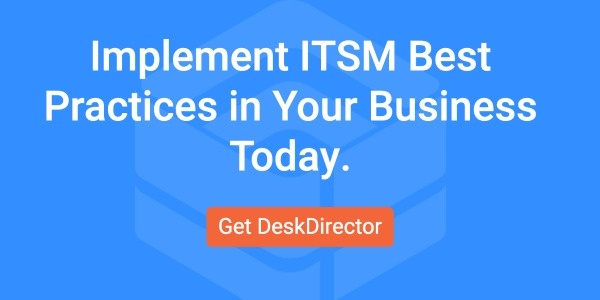Technology is now woven into the fabric of every business operation, making the management of IT assets a crucial piece of the puzzle.
What was once a straightforward task of tracking computers and software licenses has evolved into a complex, strategic function. Today, IT leaders are tasked with overseeing sprawling networks of devices, cloud platforms, and digital tools—all while finding ways to improve efficiency and cut costs.
As emerging technologies like AI, automation, and IoT reshape the field, ITSM asset management is no longer about simply maintaining systems but using them to unlock new opportunities for growth and innovation.
In this blog, we'll explore the latest trends and technologies shaping the future of ITSM asset management, providing IT leaders with insights to future-proof their operations.

The Growing Importance of ITSM Asset Management
IT asset management (ITAM) is the backbone of any modern IT operation. Effective asset management is not only about tracking hardware and software but also ensuring compliance, mitigating risks, controlling costs, and enhancing service delivery. As businesses expand their digital footprint, the volume and variety of assets have increased exponentially, creating new challenges for IT leaders.
Traditional asset management methods often fail to keep pace with today's demands. Manual processes, disconnected systems, and limited visibility into asset lifecycles lead to inefficiencies, higher costs, and increased risk. The modern IT landscape requires an approach that is agile, automated, and integrated with other IT functions, particularly ITSM.
ITSM asset management encompasses more than just tracking assets; it involves understanding the lifecycle of every IT asset, from acquisition to retirement, while ensuring that these assets are used effectively to support business operations. As organizations face tighter budgets and more complex IT environments, optimizing asset management has become essential to staying competitive and responsive to business needs.
Emerging Trends in ITSM Asset Management
1. Automation and AI-Driven Asset Management
One of the most significant trends shaping ITSM asset management is the rise of automation and artificial intelligence (AI). Automation allows IT teams to streamline routine tasks, such as inventory tracking, maintenance scheduling, and asset updates, reducing manual effort and minimizing human error. AI-driven systems take this further by leveraging machine learning to predict when assets need maintenance, flagging potential issues before they cause downtime.
Predictive analytics powered by AI can identify patterns in asset performance, helping organizations make informed decisions about repairs, replacements, and upgrades. For example, AI-based tools can analyze large datasets to determine optimal times for asset refresh cycles, improving efficiency and extending the lifespan of critical assets. In addition, AI-driven chatbots and virtual assistants can automate IT support and asset management inquiries, freeing up IT teams to focus on more strategic tasks.
2. Integration of ITAM with ITSM Systems
Gone are the days when ITAM and ITSM operated in silos. Today's IT leaders are realizing the importance of integrating IT asset management directly with their ITSM systems. This integration provides a unified platform where asset data is continuously synchronized with service management processes, offering real-time visibility into asset status, usage, and lifecycle stages.
With ITAM integrated into ITSM, organizations can automate workflows that span multiple departments. For instance, when an asset reaches the end of its lifecycle, the system can automatically trigger a service request for replacement, ensuring smooth transitions without disruption. The seamless flow of data between ITAM and ITSM systems enhances decision-making, reduces operational friction, and improves overall service delivery.
3. IoT and ITSM Asset Management
The Internet of Things (IoT) is reshaping the scope of IT asset management. As organizations deploy more IoT devices, managing these interconnected assets requires new strategies and tools. IoT sensors can monitor everything from environmental conditions to device performance in real time, providing granular data that can be used to optimize asset usage and detect issues early.
IoT-enabled asset management systems allow for real-time tracking and monitoring of physical assets. For example, a server room's temperature and humidity can be monitored to ensure optimal operating conditions, while IoT sensors can alert IT teams to any deviations that might lead to equipment failure. By integrating IoT data with ITSM platforms, organizations can automatically initiate service requests or preventive maintenance tasks when specific conditions are met, minimizing downtime and reducing manual intervention.
4. Cloud-Based Asset Management Solutions
The shift toward cloud-based ITSM platforms is accelerating, and IT asset management is following suit. Cloud-based asset management solutions offer a flexible, scalable approach to managing IT assets, especially for organizations with distributed or remote workforces. These solutions provide easy access to real-time asset data from anywhere, enabling IT teams to manage assets more efficiently and collaboratively.
Cloud-based ITSM and ITAM solutions also provide built-in scalability, allowing organizations to easily adjust to changing business needs without significant upfront investments in infrastructure. Additionally, cloud systems offer automatic updates and enhancements so that organizations can leverage the latest features and security patches without downtime or major disruptions.
5. Hybrid Work and Remote IT Asset Management
The rise of hybrid work environments has introduced new complexities in managing IT assets. With employees spread across different locations, IT leaders must manage remote devices, secure network connections, and ensure employees have the tools to remain productive.
Remote IT asset management tools are essential for monitoring and maintaining assets outside the traditional office environment. Cloud-based and mobile-friendly ITSM platforms allow IT teams to track assets remotely, push software updates, and monitor device health. Additionally, security is paramount in this context, and many remote IT asset management tools include robust cybersecurity features such as endpoint protection and encryption.
6. Blockchain Technology in IT Asset Management
While traditionally associated with cryptocurrency, blockchain technology has been found to be valuable in IT asset management. Blockchain offers an immutable and transparent ledger, making it ideal for tracking the ownership, history, and status of IT assets. This can help ensure the authenticity of assets and create a trustworthy audit trail.
Blockchain can also facilitate the secure transfer of assets between departments or locations, reducing the risk of fraud or mismanagement. As organizations continue to explore the potential of blockchain, its use in IT asset management is expected to grow, particularly in sectors that require high levels of data integrity and compliance.
7. Sustainability and Green IT Asset Management
Sustainability is increasingly becoming a priority for IT leaders, and this focus extends to IT asset management. Green ITAM strategies involve reducing e-waste, optimizing energy consumption, and ensuring that assets are disposed of in an environmentally responsible way. With regulations around environmental sustainability tightening, organizations are under pressure to adopt greener practices in managing IT assets.
Technologies such as AI and IoT can support sustainability initiatives by enabling more efficient use of resources and reducing energy consumption. For instance, AI-driven tools can monitor energy usage patterns and recommend ways to optimize the operation of data centers or IT equipment.
Advanced Technologies Driving the Future of ITSM Asset Management
Digital Twins in IT Asset Management
Digital twins, which are virtual replicas of physical assets, are emerging as a powerful tool in IT asset management. These virtual models allow IT teams to simulate, monitor, and analyze the performance of assets in real time, providing insights into potential issues before they occur. By using digital twins, organizations can optimize asset performance, reduce downtime, and plan for maintenance more effectively.
Advanced Analytics and Asset Intelligence
Data is the lifeblood of modern asset management, and advanced analytics tools are transforming how IT leaders make decisions. By leveraging big data and predictive analytics, organizations can gain deeper insights into asset performance, utilization, and total cost of ownership. These insights allow for more informed decision-making around asset procurement, maintenance, and retirement.
Augmented Reality (AR) and Virtual Reality (VR) for IT Asset Management
AR and VR technologies are making their way into IT asset management, particularly in the context of field service and maintenance. AR can overlay digital information on physical assets, helping technicians identify issues or perform repairs with visual guidance. VR can be used for virtual training, allowing IT teams to practice asset management tasks in a simulated environment.
Best Practices for IT Leaders: Adopting New ITSM Asset Management Technologies
While the benefits of these emerging trends and technologies are clear, successful adoption requires a strategic approach. IT leaders must ensure they have the right infrastructure in place, invest in training for their teams, and foster a culture of continuous improvement. It's crucial to align ITSM asset management initiatives with broader business objectives, ensuring that new technologies support overall digital transformation efforts.
Change management is also essential. As new tools and processes are introduced, IT leaders should focus on educating staff, mitigating resistance to change, and ensuring that all teams understand the value of these innovations.
ITSM Asset Management: The Conclusion
The future of ITSM asset management is being shaped by cutting-edge technologies such as AI, IoT, cloud platforms, and blockchain. By embracing these innovations, IT leaders can improve asset visibility, streamline operations, reduce costs, and align IT services with business goals. However, to fully unlock the potential of these trends, it's important to take a proactive approach, ensuring that asset management strategies are adaptable and future-proof.
Take the next step toward optimizing your ITSM asset management with DeskDirector. Our platform helps organizations streamline workflows, automate asset management, and improve service delivery—whether you're managing assets in the cloud, on-premise, or in hybrid environments. Book a demo today to learn how DeskDirector can support your ITSM strategy and drive your business forward.
Author's Bio
 Warwick Eade
Warwick Eade
Warwick Eade is the founder of DeskDirector and Lancom Technology, two pioneering companies that have redefined the landscape of IT automation and ticketing systems. As a distinguished member of the Institute of Information Technology Professionals, the IEEE Computer Society, and the NZ Software Association, Warwick brings many decades of transformative leadership and innovation to the technology sector.
Warwick’s groundbreaking journey began with a simple, yet powerful idea sketched on a whiteboard at Lancom, where he envisioned more streamlined and efficient IT systems. This vision materialized into DeskDirector, a revolutionary all-in-one ticketing automation platform that enhances organizational workflows, process management, and client relationships, benefiting everyone from IT to HR.









